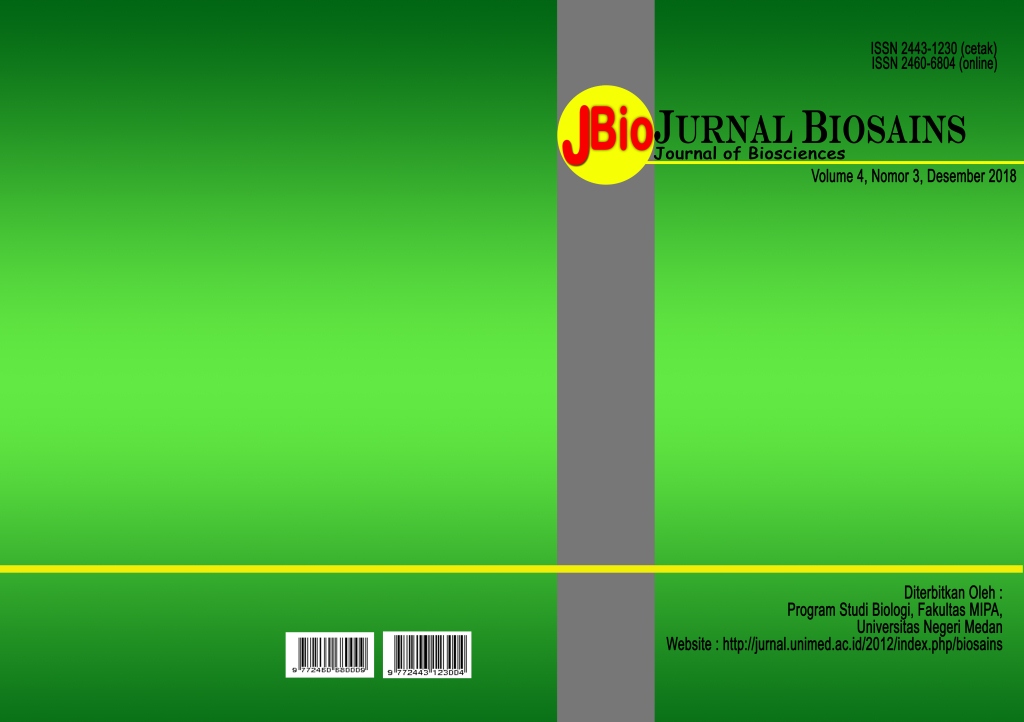RESPON PERTUMBUHAN DAN FISIOLOGIS TANAMAN SAWI (Brassica rapa var. Parachinensis) YANG DIPAPAR TIMBAL (Pb)
DOI:
https://doi.org/10.24114/jbio.v4i3.11212Keywords:
growth responses, physiology responses, mustard, lead (Pb)Abstract
The purpose of the study is to determine the influence of lead (Pb) on the growth and physiology of mustard (Brassica rapa var. Parachinensis). The research was carried out in greenhouse and chemistry laboratory of Universitas Negeri Medan and Laboratorium Kesehatan Medan from April to August 2018. This research was using a Completely Randomize Design (RAL) with 4 treatments and six replications. The treatment is the solution lead (Pb) with 4 levels of dose : 0 ppm , 1 ppm, 3 ppm, and 5 ppm. Data was analyzed by analysis of variance (ANOVA) on the SPSS program. The results showed that the lead affect the growth and physiology of mustard. Mustard which were given lead 1,3, and 5 ppm have lower height (49 cm; 41,4 cm; and 29,8 cm) than control (82,5 cm). The higher concentration of lead solution caused the lower plant height. This effects as same as to the number of leafs, plants that were treated with lead have fewer leaves (31,3 sheets; 28 sheets; and 23 sheets) than controls (38,6 sheets). The lead also affects the weight of mustard plants. Mustard that treated with lead has a lighter weight than the control. Plants treated with lead 1,3, and 5 ppm have lower chlorophyll levels (7,20 mg/L; 5,08 mg/L; and 2,17 mg/L) than controls (11,76 mg/L).References
Elly P., Irfan Dwidya Prijambada, Diah Rachmawati, Dan Retno Peni Sancayaningsih. 2012. Laju Fotosintesis Dan Kandungan Klorofil Kedelai Pada Media Tanam Masam Dengan Pemberian Garam Aluminium. Jurnal Agrotrop. 2(1): 17-24.
Flanagan JT, Wade KJ, Curie S, Curtis DJ. 1980. The Deposition of Lead and Zine From Traffic Pollution On two Road Side Shrubs Environment Pulluts. Journal Environtmental Science (Series B). 1: 71-78.
Juhaeti T, Sharif F, Hidayati N.. 2004. Inventarisasi Tumbuhan Potensial Untuk Fitoremediasi. Jurnal Biodiversitas. 1(6) : 31-33.
Kovacs, M.. 1992. Biological Indicators in Environmental Protection. New York : Ellis Horwood.
Olivares, R.A.C. 2003. Ringworm Infection in Plants. www.ivis.org. [27 Agustus 2018]
Salisbury FB and Ross C. 1995. Plant Physiology, 4th ed. California: Wadsworth Publishing Co.
Thamzil, L, Mirjani., Adila, E.Y.. 2014. Kadar Unsur Timbal Pada Tanaman Kangkung Di Tiga Pasar Tradisional Kecamatan Cilandak. 7 (1) : 2-14.
Widaningrum, Miskiyah dan Suismono. 2007. Bahaya Kontaminasi Logam Berat Dalam Sayuran dan Alternatif Pencegahan Cemarannya. Balai Besar Penelitian dan Pengembangan Pasca Panen Pertanian. Jurnal Pertanian. Vol. 3 : 11-15
www.pascapanen.litbang.deptan.go.id/media/publikasi/bulletin/2007_3.pdf. [30 Agustus 2018].
Widowati, H.. 2011. Pengaruh Logam Berat Cd, Pb Terhadap Perubahan Warna Batang dan Daun Sayuran. Jurnal Sains. 1 (4) : 167-173.
Widowati, Wahyu. 2008. Efek Toksit Logam Pencegahan Dan Penanggulangan Pencemaran.
Yogyakarta : Andi.
Downloads
Published
Issue
Section
License
Copyright (c) 2019 Vanny Harianto, Selvia Dewi Pohan

This work is licensed under a Creative Commons Attribution 4.0 International License.
For Authors Jurnal Biosains agree to the following terms:
Authors retain copyright and grant the Jurnal Biosains (JBIO) right of first publication with the work simultaneously licensed under a Creative Commons Attribution License (CC BY-SA 4.0) that allows others to share (copy and redistribute the material in any medium or format) and adapt (remix, transform, and build upon the material) the work for any purpose, even commercially with an acknowledgement of the work's authorship and initial publication in JBIO (Jurnal Biosains)
Authors are able to enter into separate, additional contractual arrangements for the non-exclusive distribution of the journal's published version of the work (e.g., post it to an institutional repository or publish it in a book), with an acknowledgement of its initial publication in JBIO (Jurnal Biosains)
Authors are permitted and encouraged to post their work online (e.g., in institutional repositories or on their website) prior to and during the submission process, as it can lead to productive exchanges, as well as earlier and greater citation of published work (See The Effect of Open Access).


